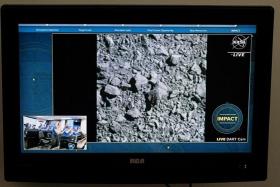Nasa ready for second attempt at Artemis launch, aiming for the moon and beyond
CAPE CANAVERAL - Ground teams at the Kennedy Space Center in Florida prepared on Saturday for a second try at launching US space agency Nasa's towering next-generation moon rocket on its debut flight, hoping to have remedied engineering problems that foiled the initial countdown five days earlier.
The 32-storey tall Space Launch System (SLS) rocket and its Orion capsule were due for blastoff from Cape Canaveral, Florida, at 1817 GMT (2.17am, Sunday, Singapore time), kicking off Nasa's ambitious moon-to-Mars Artemis programme 50 years after the last Apollo lunar mission.
The previous launch attempt on Monday ended with technical problems forcing a halt to the countdown and postponement of the uncrewed flight.
Tests indicated technicians have since fixed a leaky fuel line that contributed to the cancelled launch, Mr Jeremy Parsons, a deputy programme manager at the space centre, told reporters on Friday.
Two other key issues on the rocket itself - a faulty engine temperature sensor and some cracks in insulation foam - have been resolved to Nasa's satisfaction, Artemis mission manager Mike Sarafin told reporters on Thursday night.
Weather is always an additional factor beyond Nasa's control. The latest forecast called for a 70 per cent chance of favourable conditions during Saturday's two-hour launch window, according to the US Space Force at Cape Canaveral.
If the countdown clock were halted again, Nasa could reschedule another launch attempt for Monday or Tuesday.
Dubbed Artemis I, the mission marks the first flight for both the SLS rocket and the Orion capsule, built under Nasa contracts with Boeing and Lockheed Martin, respectively. It also signals a major change in direction for Nasa's post-Apollo human spaceflight programme, after decades focused on low-Earth orbit with space shuttles and the International Space Station.
Named for the goddess who was Apollo's twin sister in ancient Greek mythology, Artemis aims to return astronauts to the moon's surface as early as 2025.
Twelve astronauts walked on the moon during six Apollo missions from 1969 to 1972, the only space flights yet to place humans on the lunar surface. But Apollo, born of the US-Soviet space race during the Cold War, was less science-driven than Artemis.
Commercial, international partners
The new moon programme has enlisted commercial partners such as SpaceX and the space agencies of Europe, Canada and Japan to eventually establish a long-term lunar base of operations as a stepping stone to even more ambitious human voyages to Mars.
Getting the SLS-Orion spacecraft off the ground is a key first step. Its first voyage is intended to put the 2.6 million kg vehicle through its paces in a rigorous test flight pushing its design limits and hopefully proving the spacecraft suitable to fly astronauts.
If the mission succeeds, a crewed Artemis II flight around the moon and back could come as early as 2024, to be followed within a few more years with the programme's first lunar landing of astronauts, one of them a woman, with Artemis III.
Billed as the most powerful, complex rocket in the world, the SLS represents the biggest new vertical launch system the US space agency has built since the Saturn V of the Apollo era.

Barring last-minute difficulties, Saturday's countdown should end with the rocket's four main R-25 engines and its twin solid-rocket boosters igniting to produce 8.8 million pounds of thrust, about 15 per cent more thrust than the Saturn V, sending the spacecraft streaking skyward.
About 90 minutes after launch, the rocket's upper stage will thrust Orion out of Earth's orbit on course for a 37-day flight that brings it to within 96km of the lunar surface before sailing 64,374 km beyond the moon and then back to Earth.
The capsule is expected to splash down in the Pacific on Oct 11.
Moon mannequins
Although no humans will be aboard, Orion will be carrying a simulated crew of three - one male and two female mannequins - fitted with sensors to measure radiation levels and other stresses that astronauts would experience.
A top objective for the mission is to test the durability of Orion's heat shield during re-entry as it hits Earth's atmosphere at 39,429 kmh, or 32 times the speed of sound, on its return from lunar orbit - much faster than more common re-entries of capsules returning from Earth orbit.
The heat shield is designed to withstand reentry friction expected to raise temperatures outside the capsule to nearly 2,760 deg C.
More than a decade in development with years of delays and budget overruns, the SLS-Orion spacecraft has so far cost Nasa least US$37 billion (S$52 billion), including design, construction, testing and ground facilities.
Nasa's Office of Inspector General has projected total Artemis costs will run to US$93 billion by 2025.
Nasa defends the programme as a boon to space exploration that has generated tens of thousands of jobs and billions of dollars in commerce. - REUTERS
Get The New Paper on your phone with the free TNP app. Download from the Apple App Store or Google Play Store now


